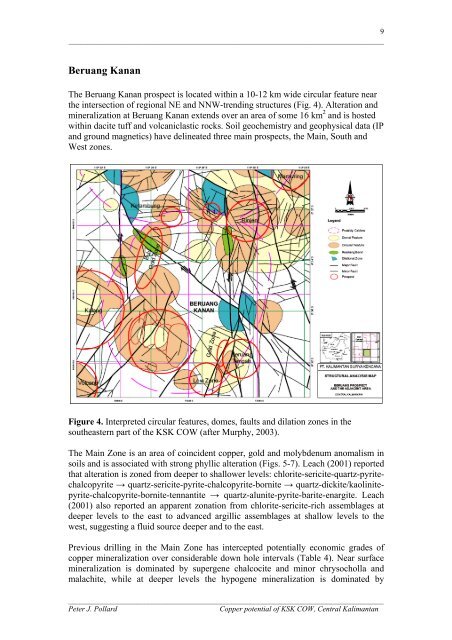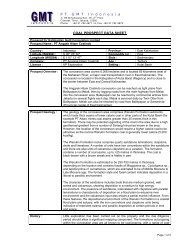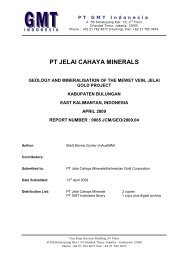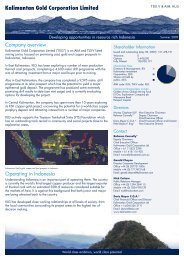Copper potential of KSK COW - Kalimantan Gold Corporation Limited
Copper potential of KSK COW - Kalimantan Gold Corporation Limited
Copper potential of KSK COW - Kalimantan Gold Corporation Limited
You also want an ePaper? Increase the reach of your titles
YUMPU automatically turns print PDFs into web optimized ePapers that Google loves.
9<br />
___________________________________________________________________________________<br />
Beruang Kanan<br />
The Beruang Kanan prospect is located within a 10-12 km wide circular feature near<br />
the intersection <strong>of</strong> regional NE and NNW-trending structures (Fig. 4). Alteration and<br />
mineralization at Beruang Kanan extends over an area <strong>of</strong> some 16 km 2 and is hosted<br />
within dacite tuff and volcaniclastic rocks. Soil geochemistry and geophysical data (IP<br />
and ground magnetics) have delineated three main prospects, the Main, South and<br />
West zones.<br />
Figure 4. Interpreted circular features, domes, faults and dilation zones in the<br />
southeastern part <strong>of</strong> the <strong>KSK</strong> <strong>COW</strong> (after Murphy, 2003).<br />
The Main Zone is an area <strong>of</strong> coincident copper, gold and molybdenum anomalism in<br />
soils and is associated with strong phyllic alteration (Figs. 5-7). Leach (2001) reported<br />
that alteration is zoned from deeper to shallower levels: chlorite-sericite-quartz-pyritechalcopyrite<br />
→ quartz-sericite-pyrite-chalcopyrite-bornite → quartz-dickite/kaolinitepyrite-chalcopyrite-bornite-tennantite<br />
→ quartz-alunite-pyrite-barite-enargite. Leach<br />
(2001) also reported an apparent zonation from chlorite-sericite-rich assemblages at<br />
deeper levels to the east to advanced argillic assemblages at shallow levels to the<br />
west, suggesting a fluid source deeper and to the east.<br />
Previous drilling in the Main Zone has intercepted <strong>potential</strong>ly economic grades <strong>of</strong><br />
copper mineralization over considerable down hole intervals (Table 4). Near surface<br />
mineralization is dominated by supergene chalcocite and minor chrysocholla and<br />
malachite, while at deeper levels the hypogene mineralization is dominated by<br />
___________________________________________________________________________________<br />
Peter J. Pollard<br />
<strong>Copper</strong> <strong>potential</strong> <strong>of</strong> <strong>KSK</strong> <strong>COW</strong>, Central <strong>Kalimantan</strong>










